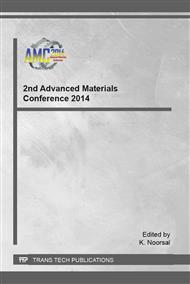[1]
B. Williams, Parmatech Shapes Metals Like Plastic, Met. Powder Rep. 44 (1989) 675-676.
Google Scholar
[2]
D. I. George, Metal Injection Moulding (MIM): Materials, Processes and Applications, 2012-(2013).
Google Scholar
[3]
H. Ö. Gülsoy, R. M. German, Production of micro-porous austenitic stainless steel by powder injection molding, Scripta Materialia. 58 (2008) 295-298.
DOI: 10.1016/j.scriptamat.2007.10.004
Google Scholar
[4]
H. I. Bakan, Injection moulding of alumina with partially water soluble binder system and solvent debinding kinetics, Materials Science and Technology. 23 (2007) 787-791.
DOI: 10.1179/174328407x161196
Google Scholar
[5]
V. M. Kryachek, Injection Moulding (Review), Powder Metallurgy and Metal Ceramics. 43 (2004) 336-348.
DOI: 10.1023/b:pmmc.0000048127.24809.d3
Google Scholar
[6]
R. Enneti, S. Park, R. German, S. Atre, Review: polymer burnout process in particulate processing, Materials and Manufacturing Processes. 27 (2012) 03-118.
DOI: 10.1080/10426914.2011.560233
Google Scholar
[7]
M. Omar, I. Subuki, N. Abdullah, N. M. Zainon, N. Roslani, Processing of Water-atomised 316L Stainless Steel Powder Using Metal-injection Processes, Journal of Engineering Science. 8 (2012) 1-13.
Google Scholar
[8]
R. M. German, A. Bose, Injection molding of metals and ceramics, (1997).
Google Scholar
[9]
X. -q. LIU, Y. -m. LI, J. -l. YUE, and F. -h. LUO, Deformation behavior and strength evolution of MIM compacts during thermal debinding, Transactions of Nonferrous Metals Society of China. 18 (2008) 278-284.
DOI: 10.1016/s1003-6326(08)60049-7
Google Scholar
[10]
L. Yimin, H. Baiyun, Q. Xuanhui, Improvement of rheological and shape retention properties of wax-based MIM binder by multi-polymer components, 9 (1999).
Google Scholar
[11]
M. R. Raza, F. Ahmad, M. Omar, R. German, Binder Removal from Powder Injection Molded 316L Stainless Steel, Journal of Applied Sciences. 11 (2011) 2042-(2047).
DOI: 10.3923/jas.2011.2042.2047
Google Scholar
[12]
F. Ahmad, Rheology of metal composity mixes for powder injection molding, International Journal of Powder Metallurgy. 41 (2005) 43-48.
Google Scholar
[13]
M. A. Porter, Effects of binder systems for metal injection molding, (2003).
Google Scholar


